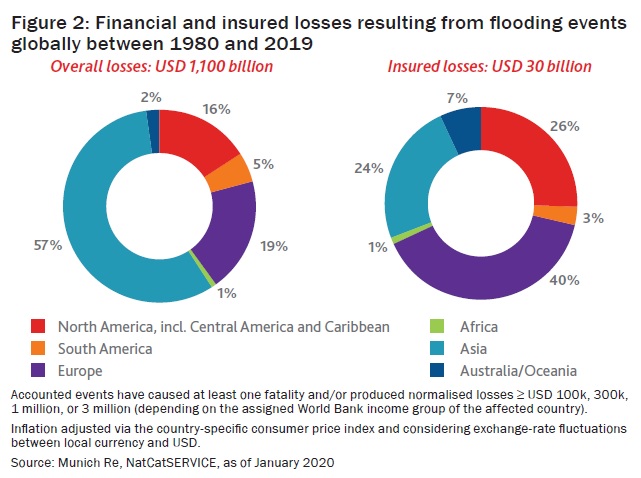As the world responds to the COVID-19 crisis and governments prepare their economic stimulus plans, the potential compounding effects of weather-related extremes such as floods, tropical cyclones and wildfires could significantly challenge a country’s emergency management capacities and slow down socio-economic recovery, says The Geneva Association’s Maryam Golnaraghi.
A new Geneva Association study, focused on building resilience to floods in a changing climate, points to the need for a paradigm shift from reacting to crises towards a risk-based, anticipatory, holistic and all-of-society approach to managing the potential impacts of catastrophes.
The costs associated with floods are exacerbated by various factors leading to growing exposure, increasing vulnerabilities and changes to the underlying hazard. These include:
- Increasing concentrations of people and assets in areas of high flood risk linked to land use, urbanisation and development practices; and
- Increasing frequency and severity of weather-related events linked to climate change (e.g. changing storm and precipitation patterns and rising sea levels).
The Geneva Association’s study takes a deep look at the evolution of flood risk management (FRM) in the US, England and Germany.
Trends and findings include:
- Flood risk: The rising socio-economic impacts of floods have become a national concern in all three countries particularly in the immediate aftermath of flood events. Recurrent, high-impact flooding has led to growing political, public and insurance industry concern, particularly around the need for action to reform FRM systems and strengthen flood resilience.
- Institutional roles and responsibilities: There is growing evidence that approaches to FRM are slowly evolving from efforts to control water to building resilience to floods. Countries are increasingly taking into consideration a risk-based and more collaborative approach to FRM. Protection of the most vulnerable citizens, particularly those residing in very high-risk areas, remains a critical issue for governments.
- Risk information and communication: In the last decade, the need for flood-risk assessment and communicating about risks has gained significant momentum although with different levels of success and impact on government, business, community and homeowner decisions. The level of risk awareness and utilisation of risk information in decision-making varies greatly among stakeholders.
- Alerts and early warnings: The three case studies confirm significant progress toward the implementation of early warning systems to enhance emergency preparedness and response operations to save lives and expedite post-disaster assessments and claims pay-outs.
- Risk reduction and risk prevention: The need for ex-ante investments in risk reduction and risk prevention measures by governments, businesses, communities and homeowners is slowly coming into focus. Implementing these measures is critical to driving affordability and to the sustainability of insurance programmes.
- Risk financing: Risk financing and contingency planning for protection of government budgets is gaining some attention, particularly at the national level. However, none of the three countries have established a pre-disaster budget or contingency planning process, with funds appropriated by the government after the event.
- Risk transfer: The value proposition of the insurance industry is evident. Beyond facilitating financial protection for recovery, the insurance sector in some countries provides flood-risk analytics and modelling, assists in flood-risk communication and awareness campaigns, and incentivising risk-reduction and risk-prevention measures.

Furthermore, limited take-up of insurance is linked to low levels of flood-risk awareness and understanding of the benefits of insurance, underestimating the potential impacts of severe floods and reliance on other support mechanisms such as post-disaster government hand-outs. Collaboration between the government and insurance industry can help boost accessibility, affordability and the sustainability of insurance as a key contributor to enhancing flood resilience, as well as promote and incentivise risk reduction and risk prevention.
- Reconstruction: There is growing recognition of the need to build back smarter after an event in order to strengthen resilience to future events in medium- and high-risk regions, with clear guidelines on how to build. However, meaningful action from those involved in the recovery and reconstruction process has been limited.
- Multi-stakeholder engagement: Cross-sectoral and multi-stakeholder collaboration and initiatives prove to be highly beneficial, although efforts are needed to develop and sustain such mechanisms beyond awareness raising and towards real action.
- Overall FRM approach: Despite all the developments, FRM systems remain, in general, reactive to floods, pointing to the need for a more anticipatory, cohesive and systems-based approach to addressing this growing risk. Furthermore, development of FRM systems need to be an integral part of economic development and climate adaptation strategies at all levels of the government.
Finally, countries need to rigorously and systematically monitor the impacts and benefits of investments in risk awareness and communication, risk reduction and risk-prevention measures in order to make ongoing improvements to the system. A
Summary of the recommendations (details available in report)
Recommendation 1: Governments should develop clear national strategies for FRM, with an anticipatory, cohesive and systems-based approach to building flood resilience, as part of their economic development and climate change adaptation plans. They should establish mechanisms to leverage the strengths and expertise of key stakeholders, particularly the private sector.
Recommendation 2: The insurance industry, as risk advisers, risk management experts, risk underwriters and investors, should increase their proactive engagement with governments and their customers to support the implementation of FRM systems to strengthen resilience to floods.
Recommendation 3: Businesses and households should proactively seek flood-risk information; understand and take responsibility for managing their flood risk; and make risk-informed decisions.
Recommendation 4: International organisations, academic institutions, professional and executive education programmes could utilise this study in their awareness-raising campaigns and educational programmes targeted at government officials, policy makers, businesses and the general public. |
All four reports on Building Flood Resilience in a Changing Climate – on the US, England and Germany as well as an overview report with key findings and recommendations – are available for download here: https://www.genevaassociation.org/building-flood-resilience
Reports on Australia and Canada are forthcoming.
Dr Maryam Golnaraghi is The Geneva Association’s director climate change and emerging environmental topics.